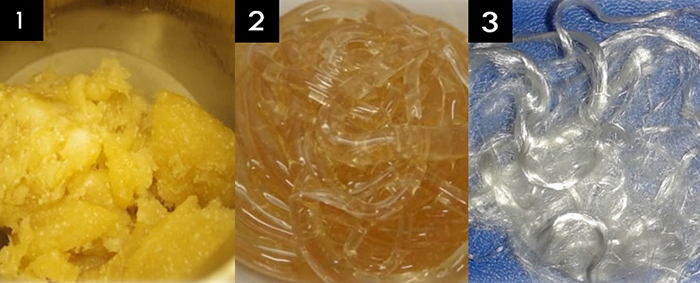Upcycling ‘fast fashion’ to reduce waste and pollution
Aalto’s Ioncell team presents their work at a meeting of the American Chemical Society.

Recycling cotton-polyester clothes is closer to reality with a new method that can (1) dissolve the blended materials, (2) separate the cellulose and (3) spin new lyocell-like fibers.
Pollution created by making and dyeing clothes has pitted the fashion industry and environmentalists against each other. Now, the advent of “fast fashion” — trendy clothing affordable enough to be disposable — has strained that relationship even more. But what if we could recycle clothes like we recycle paper, or even upcycle them?
A group of Aalto University’s researchers, led by Professor Herbert Sixta, report new progress toward that goal at the 253rd National Meeting & Exposition of the American Chemical Society (ACS).
“People don’t want to spend much money on textiles anymore, but poor-quality garments don’t last,” doctoral candidate Simone Haslinger explains. “A small amount might be recycled as cleaning rags, but the rest ends up in landfills, where it degrades and releases carbon dioxide, a major greenhouse gas. Also, there isn’t much arable land anymore for cotton fields, as we also have to produce food for a growing population.”
“We want to not only recycle garments, but we want to really produce the best possible textiles, so that recycled fibers are even better than native fibers.”
A better strategy, says Professor Herbert Sixta, who heads the biorefineries research group at Aalto University, is to upcycle worn-out garments: “We want to not only recycle garments, but we want to really produce the best possible textiles, so that recycled fibers are even better than native fibers.” But achieving this goal isn’t simple. Cotton and other fibers are often blended with polyester in fabrics such as “cotton-polyester blends,” which complicates processing.
Previous research showed that many ionic liquids can dissolve cellulose. But the resulting material couldn’t then be re-used to make new fibers. Then about five years ago, Sixta’s team found an ionic liquid that could dissolve cellulose from wood pulp, producing a material that could be spun into fibers and named the process Ioncell. Ioncell fibers are stronger than commercially available viscose and feel similar to Lyocell. Lyocell is also known by the brand name Tencel, which is a fiber favored by eco-conscious designers because it’s made of wood pulp.
Building on this process the researchers wanted to see if they could apply the same ionic liquid to cotton-polyester blends. In this case, the different properties of polyester and cellulose worked in their favor, Haslinger says. They were able to dissolve the cotton into a cellulose solution without affecting the polyester.
“I could filter the polyester out after the cotton had dissolved,” Haslinger says. “Then it was possible without any more processing steps to spin fibers out of the cellulose solution, which could then be used to make clothes.”
To move their method closer to commercialization, Sixta’s team is testing whether the recovered polyester can also be spun back into usable fibers.
To move their method closer to commercialization, Sixta’s team is testing whether the recovered polyester can also be spun back into usable fibers. In addition, the researchers are working to scale up the whole process and are investigating how to reuse dyes from discarded clothing.
The researchers received funding support from the European Union’s Trash-2-Cash project and the Finnish government.
More information at acs.org

